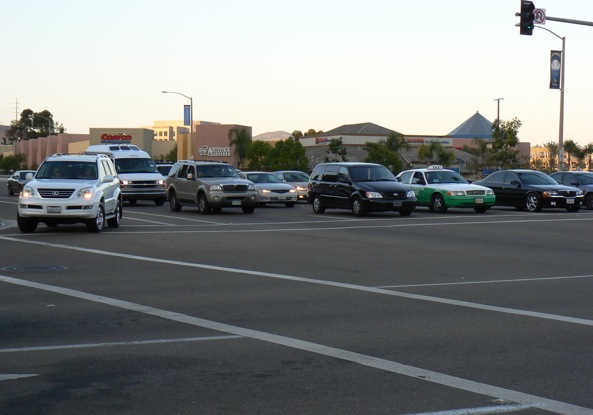The common wisdom about walkable neighborhoods holds that density – proximity to destinations – determines the number of walking trips. An ideal walking distance of a quarter mile is usually prescribed between residences and the nearest transit stop or retail center. I don’t dispute that walking distance is important, especially when I’m lugging an armload of groceries. However, some trendy high-density development favors compactness at the expense of comfort and safety.
The common wisdom about walkable neighborhoods holds that density – proximity to destinations – determines the number of walking trips. An ideal walking distance of a quarter mile is usually prescribed between residences and the nearest transit stop or retail center.
I don't dispute that walking distance is important, especially when I'm lugging an armload of groceries. However, some trendy high-density development favors compactness at the expense of comfort and safety.
An award-winning transportation research paper found that pedestrians typically walked farther than they thought to reach a transit stop: a half mile instead of a quarter mile. It also cited an absence of barriers as a major factor in the decision to walk. In my opinion, such barriers, both physical and perceived, are a stronger deterrent for pedestrians than distance. They include dangerous intersections, isolated or unsafe areas, high traffic density, parking lots, narrow sidewalks and poor lighting. If a route is pleasant and obstacle-free, pedestrians may well underestimate the time and distance of their trips.
Several new housing developments in my city are built literally within a few hundred yards of a shopping mall. But all of these dense, "mixed-use" housing-and-shopping pairs are bisected by major roads, requiring residents to cross multiple lanes of traffic in order to access shopping. (Worse, there are no grocery stores to be found, just warehouse retail. Would you walk to Costco?)
Most people are willing and able to walk more than a quarter mile; people who prefer walking would like to have the space to move. Time and distance are certainly an issue for hurried commuters, for the elderly or disabled, and during extreme weather. Still, a commute on foot can be a good replacement for a daily workout, especially when so many commuters today are sitting in their cars for hours, stuck in traffic. I have comfortably walked a few dozen blocks in New York City, but I would rather drive across the street in the neighborhood pictured above. If good urban planning is supposed to promote an active lifestyle, I wouldn't call walking 100 yards across a smoggy intersection active or healthy.

Planetizen Federal Action Tracker
A weekly monitor of how Trump’s orders and actions are impacting planners and planning in America.

Chicago’s Ghost Rails
Just beneath the surface of the modern city lie the remnants of its expansive early 20th-century streetcar system.

Amtrak Cutting Jobs, Funding to High-Speed Rail
The agency plans to cut 10 percent of its workforce and has confirmed it will not fund new high-speed rail projects.

Ohio Forces Data Centers to Prepay for Power
Utilities are calling on states to hold data center operators responsible for new energy demands to prevent leaving consumers on the hook for their bills.

MARTA CEO Steps Down Amid Citizenship Concerns
MARTA’s board announced Thursday that its chief, who is from Canada, is resigning due to questions about his immigration status.

Silicon Valley ‘Bike Superhighway’ Awarded $14M State Grant
A Caltrans grant brings the 10-mile Central Bikeway project connecting Santa Clara and East San Jose closer to fruition.
Urban Design for Planners 1: Software Tools
This six-course series explores essential urban design concepts using open source software and equips planners with the tools they need to participate fully in the urban design process.
Planning for Universal Design
Learn the tools for implementing Universal Design in planning regulations.
Caltrans
City of Fort Worth
Mpact (founded as Rail~Volution)
City of Camden Redevelopment Agency
City of Astoria
City of Portland
City of Laramie






























